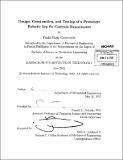Design, construction, and testing of a prototype robotic leg for controls experiments
Author(s)
Countouris, Paula Marie
DownloadFull printable version (4.774Mb)
Other Contributors
Massachusetts Institute of Technology. Dept. of Mechanical Engineering.
Advisor
Russell L. Tedrake.
Terms of use
Metadata
Show full item recordAbstract
The complex underactuated legs used in the FastRunner robot, designed by the Florida Institute for Human and Machine Cognition, are designed with multiple linkages and nonlinear springs to exploit the natural dynamics of the system in order to achieve extraordinary agility and efficiency. One way to control such a complex, underactuated system is to use a model-based control design approach based on robust nonlinear control. To develop a platform to test this physics based control design on the FastRunner leg, a free swinging underactuated robot leg was designed and constructed for benchtop controls experiments. A stand with motor to actuate the leg and a basic control system for the bench-top setup were also designed and implemented. To verify the performance of the leg, actuation, and the control setup, an open-loop step response, sinusoidal response, and chirp response were executed on the prototype leg setup. Future work includes redesign of the system electronics, construction of a system of equations that describes the leg, and completion of system identification.
Description
Thesis (S.B.)--Massachusetts Institute of Technology, Dept. of Mechanical Engineering, 2012. Cataloged from PDF version of thesis. Includes bibliographical references (p. 37).
Date issued
2012Department
Massachusetts Institute of Technology. Department of Mechanical EngineeringPublisher
Massachusetts Institute of Technology
Keywords
Mechanical Engineering.